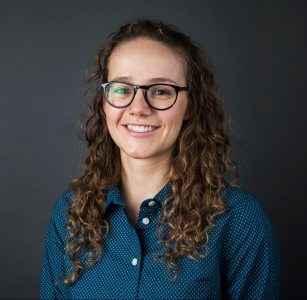
Colleen T. O'Loughlin
Assistant Professor of Chemistry and Biochemistry
Associations
Chemistry and Biochemistry
Bonney Science Center, Room 313
About
Education
- B.S., Biochemistry, Minor in Art, Ithaca College
- Ph.D., Molecular Biology, Princeton University
- Postdoctoral Scholar: Bioengineering, University of California, San Francisco and Stanford University
Courses taught
- FYS: The Chemistry of Dyes
- CHEM 107 Atomic and Molecular Structure Lecture/Lab
- CHEM217 Organic Chemistry I Lecture/Lab
- CHEM 321 Biochemistry I: Enzyme Kinetics and Biomolecular Structure Lab
- CHEM 322 Biochemistry II: Metabolism Lecture/Lab
- CHEM 337 Natural Products and Secondary Metabolites as Drugs
Research Interests
We are decidedly bad at being human on our own. Throughout the course of evolution, we outsourced essential chemistry to the bacteria that reside inside and on our bodies. These bacteria synthesize a variety of small molecules and enzymes that break down our food, educate our immune systems, inhibit the growth of pathogenic bacteria, alter neurotransmitter levels, and potentially carry out thousands of other activities we have yet to identify that could impact human health. My research focuses on identifying molecules made by prominent skin bacteria and understanding how these molecules affect the human host. Once we understand the rules for what chemical signatures enable bacteria to “talk” to us, their human host, we will engineer microbes to synthesize drug-like molecules containing these features. Such “skin probiotics” could possibly mitigate symptoms of skin diseases, including but not limited to, acne and eczema. Research in my laboratory uses techniques from biochemistry, microbiology, analytical chemistry, cell culture, and small-molecule screening.
Publications
6. Ng, K.M., Aranda-Diaz, A., Tropini, C., Frankel, M.R., Van Truren, W., O’Loughlin, C.T., Merrill, B.D., Yu, F.B., Pruss, .M., Oliveria, R.A., Higginbottom, St.K., Neff, N.F., Fischbach, M.A., Xavier, K.B., Sonnenburg, J.L., Huang, K.C. Recovery of the Gut Microbiota after Antibiotics Depends on Host Diet, Community Context, and Environmental Reservoirs. Cell Host Microbe. 2020 Oct 7;28(4):628. doi: 10.1016/j.chom.2020.09.001.
5. Tran A., Tang, A., O’Loughlin, C.T., Balistreri, A., Chang, E., Coto Villa, D., Li, J., Varshney, A., Jimenez, V., Pyle, J., Tsujimoto, B., Wellbrook, C., Vargas, C., Duong. A., Ali, N., Matthews, S.Y., Levinson,S., Woldemariam, S., Khuri, S., Bremer, M., Eggers, D.K., L’Etoile, N., Miller Conrad, L.C., Miri VanHoven, M.K., C. elegans avoids toxin-producing Streptomyces using a seven transmembrane domain chemosensory receptor. eLife. 2017; 6: e23770. Sep 5. doi: 10.7554/eLife.23770
4. Miller, L.C., O’Loughlin, C.T., Zhang, Z., Siryaporn, A., Silpe, J.E., Bassler, B.L., Semmelhack, M.F., Development of potent inhibitors of pyocyanin production in Pseudomonas aeruginosa. J Med Chem. 2015 Feb 12; 58(3): 1298–1306. Published online 2015 Feb 3. doi: 10.1021/jm5015082
3. O’Loughlin, C.T., Miller, L.C., Siryaporn, A., Drescher, K., Semmelhack, M.F., Bassler, B.L., A quorum-sensing inhibitor blocks Pseudomonas aeruginosa virulence and biofilm formation. Proc Natl Acad Sci U S A. 2013 Oct 29; 110(44): 17981–17986. Published online 2013 Oct 18. doi: 10.1073/pnas.1316981110
2. Chen, G., Swem, L.R., Swem, D.L., Stauff, D.L., O’Loughlin, C.T., Jeffrey, P.D., Bassler, B.L., Hughson, F.M., A strategy for antagonizing quorum sensing. Mol Cell. 2011 Apr 22; 42(2): 199–209. doi: 10.1016/j.molcel.2011.04.003
1. Swem, L.R., Swem, D.L., O’Loughlin, C.T., Gatmaitan, R., Zhao, B., Ulrich, S.M., Bassler, B.L., A Quorum-Sensing Antagonist Targets Both Membrane-Bound and Cytoplasmic Receptors And Controls Bacterial Pathogenicity. Mol Cell. 2009 Jul 31; 35(2): 143–153. doi: 10.1016/j.molcel.2009.05.029